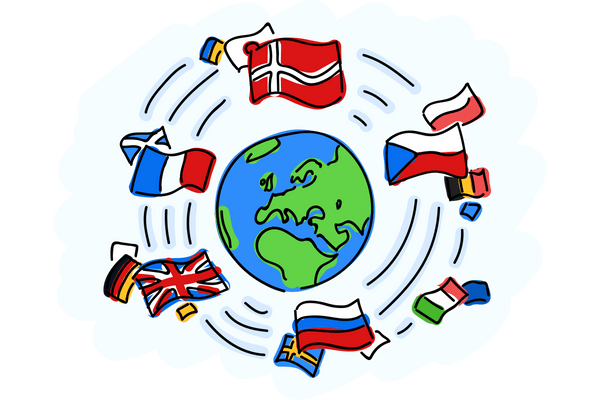
Localazy Team
Posted on July 5, 2022

If your software is already set for multilingual support and you are quickly delivering new languages with Localazy, now is the time to grow your audience and user base organically with the multilingual SEO of your website. Learn the why and how in this article.
🤔 Why is Multilingual SEO important?
Did you know that even though English is the most spoken language in the world, only 4.6% of the world’s population are native English speakers? A further 12% speak English as a second language, to varying levels of ability.
Also, consider the fact that the middle class (people with some disposable income) is set to grow at an expected rate of 6% per year (CAGR) in the developing, non-English speaking countries.
It quickly becomes obvious that there are big benefits to going multilingual if you want to capture a larger market share.
Here at Localazy, we have a team of experts in localization and translation management, including multilingual SEO, so we’ve put together this in-depth guide to getting started with multilingual SEO.
💡 What is Multilingual SEO?
We’re guessing that if you’re reading this article, you probably know the basics of SEO - that it refers to all the things you can do to your website to improve your search engine rankings. This includes things like keywords, backlinks, meta-tags, and meta-descriptions.
When it comes to multilingual SEO, we’re mainly talking about your content, keywords and meta-descriptions as they are dependent on language. If your website is only marketed to an English speaking country or countries and you don’t have any other language options, then multilingual SEO won’t really concern you.
If, on the other hand, you are in the process of taking your brand global, or already have multiple language options on your website, then you should definitely be paying close attention to multilingual SEO and localizing your content. To do this effectively, the best bet is to enlist the services of localization specialists.
🗽 Countries Separated By A Common Language
As a side note - have you ever heard the saying that the UK and USA are two countries separated by a common language? This refers to the fact that there are many differences in spelling, phrasing, and idioms between the two countries, so multilingual SEO can also refer to local differences within the same language.
For example, if your brand sells menswear, you may want to hit the keyword “trousers” in the UK, but “pants” in the USA, as the words have different meanings on either side of the pond. 👖
🌎 Benefits of Multilingual SEO
Before we dive into a step-by-step guide on how to implement multilingual SEO, let’s take a quick look at some of the benefits that are in it for you (and your customers).
- Bigger market - the global market for consumers searching for items in their native language is increasing. These days, only around 20% of internet traffic is from the USA, a figure that is dropping steadily as more and more nations develop wealth and disposable income.
- Increased conversions - marketing is all about clear messaging and if you can market goods to people in their own language, you’re far more likely to get a sale than if they are forced to translate it from English, a language they may not have a good grip on.
- Search engine ranking boost - ensuring that your website and blogs are optimized for the best performing keywords in all your target market languages will help you to climb the search engine rankings.
🏆 Multilingual SEO - Steps To Success
Step 1 - Develop a strategy
The first thing you need to do is set out your plan. Which countries are you going to target? To do this, you need to look into a variety of factors for each country, including:
- Market availability or attractiveness - do people in that country actually want what you’re selling
- Size of the available market - you should have some basic figures on how big the market is
- Economic factors - do people have the financial means to buy your products or services
Once you have the above details, you can rank the countries by attractiveness and decide which languages to concentrate on for your multilingual SEO strategy.
Step 2 - Do your research
When people talk about SEO, the first thing that springs to mind is keywords. But focusing on keywords right from the outset is a bit of a mistake. You’re far better off researching topics and basing your SEO strategy around topic areas rather than going straight in and trying to hit keywords.
This is especially true when it comes to multilingual SEO. For instance, let’s imagine that you sell sporting goods. If you’re selling items to the UK market, finding keywords for 🏏 cricket may be a highly successful strategy. Less so if you’re selling items in Spain. In other words, you need to localize your content topics to find keywords that will resonate in different regions.
Step 3 - Research keywords
Once you know which countries and regions you’re going to focus on, you can do your on-page keyword research. To do this, you need to use a tool that will give you search volume stats for different languages, as well as keyword difficulty and search intent data. Tools such as Semrush can help with this.
For the best results, you should consider hiring SEO language and localization experts such as Localazy to research and identify the best keywords across a variety of languages. A team of highly-skilled translators will also help you to accurately translate your English text perfectly, while simultaneously applying the SEO keywords at the desired density.
Step 4 - Apply on-page and technical multilingual SEO
The penultimate stage is to apply the multilingual SEO strategy and keywords. Again, this can be extremely complex and time-consuming to do by yourself, so we suggest that you enlist the services of multilingual SEO specialists.
Hiring professional multilingual SEO experts also means that you will get in-depth monitoring and analysis of your strategy. They will also optimize and adapt your strategy and implementation as things progress.
Another advantage of using localization and translation experts is that they will allow for expansion and contraction of text, which is important for meta-descriptions. When you translate from one language to another, you often gain or lose the quantity of characters. As meta-description character counts are limited, this can cause SEO problems, but a professional team will allow for these technical elements and adjust the text to suit.
Example technique - using the hreflang attribute
Another example of multilingual SEO techniques is the utilization of the hreflang attribute. Everyone knows that content is king, and translating content to multiple languages is a powerful SEO technique for your organic traffic growth.
With Localazy, you can translate your website seamlessly - Order translations in the Marketplace and let Localazy handle the localization process for you.
🚀 Learn more about our Continuous Localization services.
However, it is not only about cloning a page, filling it with translated texts, and calling it a day. You must ensure that content with multiple language versions is properly identified and interlinked via the hreflang attribute.
Example use of the hreflang attribute:
< link rel="alternate" href="http://example.com" hreflang="en-us" />
This attribute tells browsers and search engines that the page is in US English. Other versions of this page (e.g., German and Czech) should be linked similarly:
< link rel="alternate" href="http://example.com/your-product" hreflang="en-us" />
< link rel="alternate" href="http://example.de/beispielprodukt" hreflang="de-de" />
< link rel="alternate" href="http://example.cz/vzorovy-produkt" hreflang="cs-cs" />
There are many more aspects to consider which would fill a book of multilingual SEO techniques. (Should we write one?) But, if you don't have the time to dive deep into multilingual SEO, you should hire professionals in the field to help you implement everything correctly to get the most out of your multilingual content.
🚩 Get High-quality Multilingual SEO Results
With help from from professional translators and localization experts at Localazy, we can provide all the services and tools you need to break through to new global markets and improve your search engine rankings in every country you decide to target.
Contact us today to discuss your global SEO needs.
📚 You might also like

Posted on July 5, 2022
Join Our Newsletter. No Spam, Only the good stuff.
Sign up to receive the latest update from our blog.


